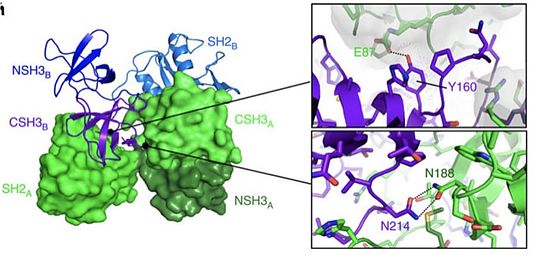User:Charli Barbet/Sandbox
From Proteopedia
(Difference between revisions)
| Line 35: | Line 35: | ||
Following this pathway and the formation of a complex between Grb2 and [http://www.uniprot.org/uniprot/Q07889 SOS], the [http://www.uniprot.org/uniprot/P01112 RAS] protein is activated. Interestingly, [http://www.uniprot.org/uniprot/P01112 RAS] is a g-protein implicated in the activation of [http://www.uniprot.org/uniprot/P04049 RAF-1]. The latest activates of the [https://en.wikipedia.org/wiki/MAPK/ERK_pathway MEK downstream cascade pathway] ([http://www.uniprot.org/uniprot/Q02750 MEK1]/ [http://www.uniprot.org/uniprot/P36507 MEK2] et [http://www.uniprot.org/uniprot/P27361 ERK1 ]/ [http://www.uniprot.org/uniprot/P28482 ERK2]) involved in the translocation of [https://en.wikipedia.org/wiki/Extracellular_signal–regulated_kinases ERK factors] from the cytosol to the nucleus for the activation of [http://www.uniprot.org/uniprot/P19419 Elk-1] and [http://www.uniprot.org/uniprot/P01106 Myc transcription Factor]. These particular [https://en.wikipedia.org/wiki/Transcription_factor transcription factor] participate in the activation of SRE containing gene leading to cellular growth. | Following this pathway and the formation of a complex between Grb2 and [http://www.uniprot.org/uniprot/Q07889 SOS], the [http://www.uniprot.org/uniprot/P01112 RAS] protein is activated. Interestingly, [http://www.uniprot.org/uniprot/P01112 RAS] is a g-protein implicated in the activation of [http://www.uniprot.org/uniprot/P04049 RAF-1]. The latest activates of the [https://en.wikipedia.org/wiki/MAPK/ERK_pathway MEK downstream cascade pathway] ([http://www.uniprot.org/uniprot/Q02750 MEK1]/ [http://www.uniprot.org/uniprot/P36507 MEK2] et [http://www.uniprot.org/uniprot/P27361 ERK1 ]/ [http://www.uniprot.org/uniprot/P28482 ERK2]) involved in the translocation of [https://en.wikipedia.org/wiki/Extracellular_signal–regulated_kinases ERK factors] from the cytosol to the nucleus for the activation of [http://www.uniprot.org/uniprot/P19419 Elk-1] and [http://www.uniprot.org/uniprot/P01106 Myc transcription Factor]. These particular [https://en.wikipedia.org/wiki/Transcription_factor transcription factor] participate in the activation of SRE containing gene leading to cellular growth. | ||
| - | On the other hand, in [https://en.wikipedia.org/wiki/T_cell T lymphocytes], the simulation of [https://en.wikipedia.org/wiki/T-cell_receptor TCRs] induces tyrosine phosphorylation on a wide range of of cellular proteins such as [http://www.uniprot.org/uniprot/P07355 p36]-[http://www.uniprot.org/uniprot/Q16539 p38] or [http://www.uniprot.org/uniprot/O43561 LAT]. As an example, the phosphorylated residues of [http://www.uniprot.org/uniprot/O43561 LAT] can bind the SH2 domain of Grb2 while the formation of this complex recruits on the SH3 domain some proteins of the [https://en.wikipedia.org/wiki/Vav_(protein) VAV family]. [http://www.uniprot.org/uniprot/P15498 VAV proteins] are guanine nucleotide exchange factors ([https://en.wikipedia.org/wiki/Guanine_nucleotide_exchange_factor GEF]) for the [https://en.wikipedia.org/wiki/GTPase GTPase proteins] of the [https://en.wikipedia.org/wiki/Rho_family_of_GTPases Rho family]. | + | On the other hand, in [https://en.wikipedia.org/wiki/T_cell T lymphocytes], the simulation of [https://en.wikipedia.org/wiki/T-cell_receptor TCRs] induces tyrosine phosphorylation on a wide range of of cellular proteins such as [http://www.uniprot.org/uniprot/P07355 p36]-[http://www.uniprot.org/uniprot/Q16539 p38] or [http://www.uniprot.org/uniprot/O43561 LAT]. As an example, the phosphorylated residues of [http://www.uniprot.org/uniprot/O43561 LAT] can bind the SH2 domain of Grb2 while the formation of this complex recruits on the SH3 domain some proteins of the [https://en.wikipedia.org/wiki/Vav_(protein) VAV family]. [http://www.uniprot.org/uniprot/P15498 VAV proteins] are guanine nucleotide exchange factors ([https://en.wikipedia.org/wiki/Guanine_nucleotide_exchange_factor GEF]) for the [https://en.wikipedia.org/wiki/GTPase GTPase proteins] of the [https://en.wikipedia.org/wiki/Rho_family_of_GTPases Rho family]. This complex has for main aim to introduce a Calcium flux and the activation of [https://en.wikipedia.org/wiki/Mitogen-activated_protein_kinase MAP kinase] allowing [https://en.wikipedia.org/wiki/T_cell T lymphocyte] proliferation. |
| - | This complex has for main aim to introduce a Calcium flux and the activation of MAP kinase allowing | + | |
Finally, it was proven that Grb2 in the negative regulation of [http://www.uniprot.org/uniprot/P00533 EGFR]. Indeed, [http://www.uniprot.org/uniprot/P22681 c-Cbl] is a protein implicated in the [http://www.uniprot.org/uniprot/O60260 E3] complex of [http://www.uniprot.org/uniprot/P00533 EGFR] ubiquitination, hence also its degradation [http://www.uniprot.org/uniprot/P22681 C-Cbl] thanks to its SH2 domain can directly bind to [http://www.uniprot.org/uniprot/P00533 EGFR] causing its degradation (Grb2 independent regulation). Yet [http://www.uniprot.org/uniprot/P22681 c-Cbl] can also indirectly bind to [http://www.uniprot.org/uniprot/P00533 EGFR] via its SH3 domain recognition by Grb2 (Dependant Grb2 regulation). The direct or indirect binding of [http://www.uniprot.org/uniprot/P22681 c-Cbl] on [http://www.uniprot.org/uniprot/P00533 EGFR] induce the recruitment of enzymes that are necessary for the ubiquitination of [http://www.uniprot.org/uniprot/P00533 EGFR]. Ubiquitination being a signal for protein degradation. It is important to note that negative regulation is more important when Grb2 is implicated and bound to [http://www.uniprot.org/uniprot/P22681 c-Cbl] rather than when [http://www.uniprot.org/uniprot/P22681 c-Cbl] is the only protein involved. | Finally, it was proven that Grb2 in the negative regulation of [http://www.uniprot.org/uniprot/P00533 EGFR]. Indeed, [http://www.uniprot.org/uniprot/P22681 c-Cbl] is a protein implicated in the [http://www.uniprot.org/uniprot/O60260 E3] complex of [http://www.uniprot.org/uniprot/P00533 EGFR] ubiquitination, hence also its degradation [http://www.uniprot.org/uniprot/P22681 C-Cbl] thanks to its SH2 domain can directly bind to [http://www.uniprot.org/uniprot/P00533 EGFR] causing its degradation (Grb2 independent regulation). Yet [http://www.uniprot.org/uniprot/P22681 c-Cbl] can also indirectly bind to [http://www.uniprot.org/uniprot/P00533 EGFR] via its SH3 domain recognition by Grb2 (Dependant Grb2 regulation). The direct or indirect binding of [http://www.uniprot.org/uniprot/P22681 c-Cbl] on [http://www.uniprot.org/uniprot/P00533 EGFR] induce the recruitment of enzymes that are necessary for the ubiquitination of [http://www.uniprot.org/uniprot/P00533 EGFR]. Ubiquitination being a signal for protein degradation. It is important to note that negative regulation is more important when Grb2 is implicated and bound to [http://www.uniprot.org/uniprot/P22681 c-Cbl] rather than when [http://www.uniprot.org/uniprot/P22681 c-Cbl] is the only protein involved. | ||
| Line 42: | Line 41: | ||
== Interactions == | == Interactions == | ||
| - | [http://www.uniprot.org/uniprot/Q07889 '''Sos1''']: Promotes the exchange of [http://www.uniprot.org/uniprot/P01112 Ras]-bound GDP into GTP, by promoting the [http://www.uniprot.org/uniprot/P01112 Ras] specific guanine nucleotide exchange factor activity. | + | [http://www.uniprot.org/uniprot/Q07889 '''Sos1''']: Promotes the exchange of [http://www.uniprot.org/uniprot/P01112 Ras]-bound [https://en.wikipedia.org/wiki/Guanosine_diphosphate GDP] into [https://en.wikipedia.org/wiki/Guanosine_triphosphate GTP], by promoting the [http://www.uniprot.org/uniprot/P01112 Ras] specific guanine nucleotide exchange factor activity. |
[http://www.uniprot.org/uniprot/P29353 '''Shc''']: [http://www.uniprot.org/uniprot/P29353 Shc] is important in the regulation of apoptosis and drug resistance in mammalian cells. She is implicated in the EGFR pathway. | [http://www.uniprot.org/uniprot/P29353 '''Shc''']: [http://www.uniprot.org/uniprot/P29353 Shc] is important in the regulation of apoptosis and drug resistance in mammalian cells. She is implicated in the EGFR pathway. | ||
Revision as of 13:47, 13 January 2017
Grb2 (1gri)
| |||||||||||



